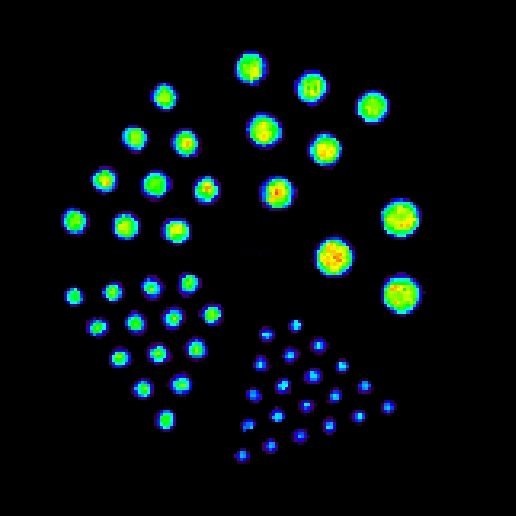 |
 |
 In
nuclear medicine applications, image reconstruction from
radio-nuclide emissions is known as computed tomography (CT) and its
purpose is the localisation of the emission hot spots. Various image
reconstruction algorithms exist, and their applicability depends,
among other factors, on the type of scanning apparatus (PET, PEM,
SPECT, Compton camera) and the type of emission nucleide (e.g.
positron emission or single gamma). Important concepts in medical
imaging are the field of view (FOV), which is the space onto which
the image is reconstructed and the projection data, which reflects
how the emission radiation is projected onto the detector (i.e. the
measured data).
In
nuclear medicine applications, image reconstruction from
radio-nuclide emissions is known as computed tomography (CT) and its
purpose is the localisation of the emission hot spots. Various image
reconstruction algorithms exist, and their applicability depends,
among other factors, on the type of scanning apparatus (PET, PEM,
SPECT, Compton camera) and the type of emission nucleide (e.g.
positron emission or single gamma). Important concepts in medical
imaging are the field of view (FOV), which is the space onto which
the image is reconstructed and the projection data, which reflects
how the emission radiation is projected onto the detector (i.e. the
measured data).
Figure 1. Derenzo Phantom.
With
FBP, a Fourier transform, a frequency filter and, subsequently, an
inverse Fourier transform are applied to the data before doing
back-projection. The main drawback of FBP is that it requires a
detector with an angular coverage of at least 180 degrees and hence
cannot be used for PEM and Compton gamma cameras without producing
artifacts in the final image. OSEM is an iterative algorithm, where
an image estimate is forward projected onto the detector and after
comparing the projected data with the real measured data, a cost
function is used to update the image estimate. The main problem with
OSEM for a Compton gamma camera with a large number of channels is
that it requires an impractical large memory and CPU-time consumption
since the total number of detector bins in the system matrix depends
on all possible combinations of all channels in the two Compton
camera detector planes. A list mode implementation of OSEM (LM-OSEM),
might reduce this disadvantage but still there are various issues
involved in optimizing the algorithm, such as the search algorithm
for finding the FOV bins that lie on the Compton cone (or the LOR in
the case of PET and PEM), and to what extent potential tracks should
be weighted with their corresponding cross-section. As an
alternative, the Origin Ensemble (OE) algorithm can be used, which is
based on a stochastic approach. Here, iteratively, random positions
are assigned in the FOV for the Compton cones or LORs, with
probabilities depending on the density of positions in each of the
FOV bins. Due to the stochastic nature of the algorithm, various
trial runs have to be executed and the final result is an average of
these. Also, to counteract the finite spatial resolution of the
detectors, a additional resolution recovery mechanism has to be added
to the mechanism. To evaluate these image reconstruction algorithms,
they should be tested on various phantom sources (such as the Derenzo
phantom shown in the figure 1) where the results should be compared
by using various image quality criteria.